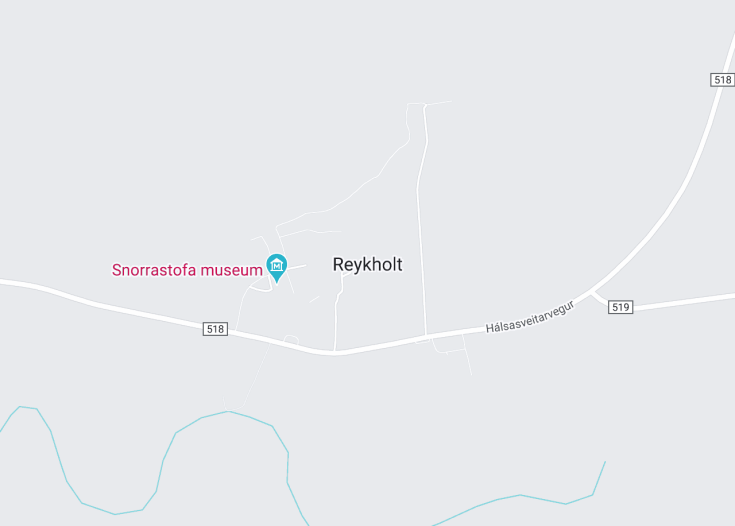Reykholt is one of Iceland’s most notable historical sites, embodying a rich tapestry of cultural and literary heritage. This small village in Western Iceland was once the home of the medieval scholar Snorri Sturluson, who authored many of Iceland’s sagas. Today, Reykholt remains a captivating portal to the past, hosting ruins and artifacts that tell stories of medieval life. Visitors can explore Snorri’s pool, one of the oldest surviving man-made structures in Iceland, and the Snorrastofa museum dedicated to his life and works.
As you plan your visit to Reykholt, consider timing your trip to coincide with one of the local cultural events or lectures often held at Snorrastofa, which offer deep dives into Norse mythology and medieval history.
To make the most out of your Reykholt experience, start your tour at Snorrastofa to gain contextual background that will enrich your exploration of the site and surrounding area.
Top things to do & see in Reykholt
Select the following sights and activities to discover best tickets and tours available in Reykholt.
Reykholt: Gateway to Iceland’s History
| Country | Iceland |
| Time in Reykholt | GMT-0 |
| Language spoken | Icelandic |
| Population | 300 (Statistics Iceland, 2023) |
| Currency | Icelandic króna (ISK, kr) |
| Airports |
|
Reykholt, nestled in a fertile valley in West Iceland, is one of the country’s most significant historical sites. It was the home of Snorri Sturluson, one of Iceland’s most revered medieval authors, chieftains, and politicians during the 13th century. Today, Reykholt continues to captivate visitors with its rich history and beautiful landscapes, making it an essential destination for history buffs and nature lovers alike.
Where is Reykholt?
Reykholt is located in Western Iceland, approximately 100 kilometers northeast of the capital city of Reykjavik.
Distances:
| Route | Distance by car | Time by car |
|---|---|---|
| Reykjavik to Reykholt | 100 km | 1 hour 30 minutes |
| Akureyri to Reykholt | 277 km | 3 hours 35 minutes |
| Selfoss to Reykholt | 137 km | 1 hour 50 minutes |
What is Reykholt famous for?
Reykholt is most famous for being the residence of Snorri Sturluson, an influential figure in Icelandic history who wrote several medieval texts that are crucial to understanding Norse mythology and early Icelandic culture.
History
Settlement Era (870-930)
The history of Reykholt, one of Iceland’s notable historical sites, begins with the earliest settlers during the Settlement Era. Norsemen, seeking new lands, arrived, drawn by the geothermal activity and fertile lands. It quickly became an area marked by farming and burgeoning cultural significance. Reykholt’s strategic location made it a desirable seat for chieftains and influential figures.
The Saga Age (930-1262)
Reykholt entered its golden age with the residence of Snorri Sturluson, a noted scholar, chieftain, and the author of the Prose Edda, around the early 13th century. His contributions to Norse literature and mythology were penned from this location, making the area a literary and political hub. During this period, Reykholt thrived as a centre of enlightenment, attracting scholars and clerics.
Reformation to Independence (1530-1944)
Following the Reformation, Reykholt, like much of Iceland, saw a move from the Catholic Church to Lutheranism, impacting the local cultural and theological landscape. The area maintained its educational importance, continuing to foster a rich tradition of Icelandic literary and historical scholarship. During the early 20th century, Iceland’s movement towards independence saw Reykholt as a quiet witness to national transformation.
Modern Era (1944-Present)
In contemporary times, Reykholt remains a testament to its storied past, balancing historical preservation with modernity. Its role has shifted predominantly to tourism, allowing visitors worldwide to delve into its rich historical tapestry, capturing insights from the Settlement Era to the independence of Iceland. Today, Reykholt not only stands as a cultural heritage site but also as a vibrant community reflecting a blend of past and present.
Visit Reykholt
What to see and do in Reykholt
Reykholt is a treasure trove of history and natural beauty. Visitors can explore the Snorralaug Hot Pool, an ancient geothermal pool believed to have been used by Snorri Sturluson himself. The Snorrastofa Cultural and Medieval Centre offers in-depth exhibitions on medieval Iceland, focusing on Snorri’s works and life. For those entranced by architecture, the modern church at Reykholt, designed with elements reflecting Iceland’s natural landscape, is a must-see. Nature enthusiasts can enjoy the nearby Hraunfossar and Barnafoss waterfalls, showcasing spectacular natural water features unique to the region.
- Snorralaug Hot Pool
- Snorrastofa Cultural and Medieval Centre
- Modern Church of Reykholt
- Hraunfossar and Barnafoss Waterfalls
Festivals and Events in Reykholt
Reykholt hosts several cultural events throughout the year, celebrating its rich history and community spirit. The most prominent is the Reykholt Music Festival, held every summer, which features classical and contemporary music performed in historic locations, including the beautiful Reykholt Church.
Best time to visit Reykholt
The best time to visit Reykholt is during the summer months from June to August when the weather is most favorable for exploring the outdoors and the daylight hours are extended, perfect for soaking in the historical sites and natural landscapes.
Is Reykholt worth visiting?
Reykholt is undoubtedly worth a visit for anyone interested in history, literature, or nature. Its rich historical context as the home of Snorri Sturluson, coupled with its stunning natural surroundings, makes it a unique destination. The blend of educational experiences and the serene landscape offers a deeply fulfilling journey for all visitors, making it a standout destination in Iceland.










